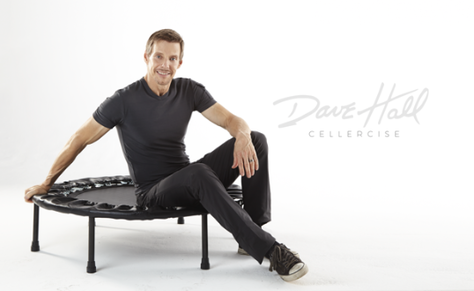WHY THE CELLERCISER® IS THE BEST!
Here are some in-depth reviews why the Cellerciser® is your only choice when it comes to quality health and lasting results!
|
Q & A With Founder, Dave Hall
|
Why Choose A Cellerciser?
|
Below are some quick 3 minute or less videos that explain in great detail why the Cellerciser® is the best rebounder available!
|
Why Passionate About Cellercising?
|
Why Do You Call It, "Cellercise"?
|
|
Why Did You Start Cellercising?
|
What Are The Medical Benefits?
|
|
How Jumping Improves Health!
|
What Cellercising Does To Muscles!
|
|
Don't Tear Down Your Muscles!
|
Why Only 10 Minutes A Day?
|
|
What If 10 Minutes Could Do This?
|
Who Can Use The Cellerciser?
|
|
The Truth About The Cellerciser!
|
Why Is The Cellerciser Unique?
|

“Can the Cellerciser really change your life in just 10 minutes a day?”
“I promise results with a 30 day money back guarantee”
- Dave Hall (Owner/CEO)
How does it work?
As you move up and down so does all the fluid in your body. The Cellerciser rebounder increases circulation, opens up capillaries, breaks up blockages and stimulates internal organ production.
Additionally, it is being used effectively to help with back, knee, and shoulder issues, blood pressure, balance, stress and as written by Dr. Morton Walker:
The following benefits have been attributed to Cellercising by Dr. Morton Walker who is the author of Jumping for Health.
Dave Hall, the inventor of the Cellerciser has spent the last three decades not only perfecting his rebounder design, but also developing exercises that are literally designed from your head to your toes.
Many with Type 1 and 2 Diabetes have been able to use the Cellerciser and see dramatic results.
“Being a type I diabetic, consistent daily exercise is a necessity. I've used the Cellerciser and no other form of exercise each day since I first bought it two weeks ago, and have had near perfect blood sugar results each time I test! This product is remarkable, I've been telling everyone about it! Thank you!”
-Andrew R.
Like Andrew there is a certainty that not all that live with Diabetes are excited to even try to workout on a daily basis. Getting a gym membership is a great step, but after the drive from the first day begins to follow with excuses of why you can't go.
“I’m too busy” or the standby favorite “It is just too hard”.
This is felt by so many each and every day which leads diabetics to give up and slowly let their disease take over.
What if having fun for 10 minutes a day could help you achieve a healthier, and more vibrant YOU?
People are experiencing tremendous results while using the Cellercise rebounder, gaining more energy, mental clarity, and overall health. Better blood sugar levels, the feeling of empowerment, and improved diets are all being shared in the many written letters and emails expounding the Cellerciser. (Click "HERE" for Past Diabetic Cellerciser Experiences)
Although often referred to as a rebounder....The Cellerciser is NOT a typical exercise mini trampoline. It uses a patented Tri-flex spring, space-age mat material that resists pronation of the feet. The Cellerciser is built from the ground up with quality.
Better built!
Better performance equals better results!
The Cellerciser is the longest lasting mini-trampoline on the market!
“I promise results with a 30 day money back guarantee”
- Dave Hall (Owner/CEO)
How does it work?
As you move up and down so does all the fluid in your body. The Cellerciser rebounder increases circulation, opens up capillaries, breaks up blockages and stimulates internal organ production.
Additionally, it is being used effectively to help with back, knee, and shoulder issues, blood pressure, balance, stress and as written by Dr. Morton Walker:
The following benefits have been attributed to Cellercising by Dr. Morton Walker who is the author of Jumping for Health.
- Increase balance and coordination
- reduce cardiovascular disease risk
- Increase red blood cell production
- Aid in lymphatic circulation
- Strengthen heart
- Lower resting heart rate
- Strengthen muscles
- Reduce cholesterol levels
- Reduce triglyceride levels
- Stimulate metabolism
- Improve vision
- Promote growth and repair
- Increase breathing capacity
- Increased oxygenation of tissues
- Tone the glandular system
- Increase thyroid output
- Expand capacity for fuel storage
- Increase muscle vigor
- Tone muscle fibers
- Reduce headaches
- Relieve back pain
- Reduce aches & pains from inactivity
- Improve digestion/elimination
- Allow for deeper, easier sleep
- Stimulate mental performance
- Stimulate learning process
- Lessen PMS symptoms
- Slow the aging process
- Reduce chances of obesity
Dave Hall, the inventor of the Cellerciser has spent the last three decades not only perfecting his rebounder design, but also developing exercises that are literally designed from your head to your toes.
Many with Type 1 and 2 Diabetes have been able to use the Cellerciser and see dramatic results.
“Being a type I diabetic, consistent daily exercise is a necessity. I've used the Cellerciser and no other form of exercise each day since I first bought it two weeks ago, and have had near perfect blood sugar results each time I test! This product is remarkable, I've been telling everyone about it! Thank you!”
-Andrew R.
Like Andrew there is a certainty that not all that live with Diabetes are excited to even try to workout on a daily basis. Getting a gym membership is a great step, but after the drive from the first day begins to follow with excuses of why you can't go.
“I’m too busy” or the standby favorite “It is just too hard”.
This is felt by so many each and every day which leads diabetics to give up and slowly let their disease take over.
What if having fun for 10 minutes a day could help you achieve a healthier, and more vibrant YOU?
People are experiencing tremendous results while using the Cellercise rebounder, gaining more energy, mental clarity, and overall health. Better blood sugar levels, the feeling of empowerment, and improved diets are all being shared in the many written letters and emails expounding the Cellerciser. (Click "HERE" for Past Diabetic Cellerciser Experiences)
Although often referred to as a rebounder....The Cellerciser is NOT a typical exercise mini trampoline. It uses a patented Tri-flex spring, space-age mat material that resists pronation of the feet. The Cellerciser is built from the ground up with quality.
Better built!
Better performance equals better results!
The Cellerciser is the longest lasting mini-trampoline on the market!
Science Backs The Cellerciser® Too!
Just when you thought that the videos above were enough information to help you learn why we have the best rebounder out there...we are proud to present some evidence-based research proclaiming the value of rebounding over running or using a treadmill!
ALBERT E. CARTER was quoted saying:
“Rebound exercise is the most efficient, effective form of exercise yet devised by man.”
(The Miracles of Rebound Exercise; Carter, Albert E.; The National institute of Reboundology and Health, Inc. Edmonds, Washington, 1979.)
Our beloved NASA program was equally quoted from an empirical research study conducted in 1980:
“…for similar levels of heart rate and oxygen consumption, the magnitude of the biomechanical stimuli is greater with jumping on a trampoline than with running, a finding that might help identify acceleration parameters needed for the design of remedial procedures to avert deconditioning in persons exposed to weightlessness. “
The above statement is one of several made in a scientific study published in the Journal of Applied Physiology 49(5): 881-887, 1980, which confirms many of the statements previously made in The Miracles of Rebound Exercise, 1979. The research was performed by the Biomechanical Research Division, NASA-Ames Research Center, Moffett Field, California, in cooperation with the Wenner-Gren Research laboratory, University of Kentucky, Lexington, Kentucky.
The four scientists, A, Bhattacharya, E. p, McCutcheon, E. Shvariz, and J, E. Greenleaf, secured the assistance of eight young men between the ages of 19 and 26 to each walk, jog, and run on a treadmill which was operated at four different speeds and then jump on a standard sized trampoline at four different heights to compare the difference between the two modes of exercise.
Although treadmill running had been studied many times before, the scientists found that “…measurements of the necessary variables have not been reported previously for trampoline exercise.” The trampoline testing was conducted at least one week after the treadmill testing.
For those of you who would prefer the full abstract verbatim we left it for your reading pleasure!
Journal of Applied Physiology 49(5): 881-887, 1980.
Body Acceleration Distribution and O2 Uptake in Humans during Running and Jumping.
Bhattacharya A, McCutcheon EP, Shvartz E, Greenleaf JE.
Abstract
Body acceleration distribution and its relation to the mode of generation were determined in eight young males (19-26 yr) who walked and ran on a treadmill operated at four speeds and jumped on a trampoline at four heights. With increasing treadmill speed, peak acceleration at the ankle (Aa = 3.0-12.0 Gz) always exceeded that at the back and forehead (Ab = 0.9-5.0 Gz, and Ah = 0.8-3.9 Gz); these acceleration profiles included higher frequency components than those during jumping. Corresponding ranges of oxygen uptake (VO2) and heart rate (HR) were 0.8-3.0 l/min and 90-180 beats/min, respectively. With increasing jumping height, acceleration levels were more symmetrically distributed (Aa = 3.0-7.0 Gz, Ab = 3.9-6.0 Gz, and Ah = 3.0-5.6 Gz); VO2 and HR ranges were 1.1-2.5 l/min and 102-175 beats/min, respectively. VO2 was linearly related to HR for both types of exercise. The results indicate that, for similar levels of HR and VO2, the magnitude of the biomechanical stimuli is greater with jumping on a trampoline than with running, a finding that might help identify acceleration parameters needed for the design of remedial procedures to avert deconditioning in persons exposed to weightlessness.
ALBERT E. CARTER was quoted saying:
“Rebound exercise is the most efficient, effective form of exercise yet devised by man.”
(The Miracles of Rebound Exercise; Carter, Albert E.; The National institute of Reboundology and Health, Inc. Edmonds, Washington, 1979.)
Our beloved NASA program was equally quoted from an empirical research study conducted in 1980:
“…for similar levels of heart rate and oxygen consumption, the magnitude of the biomechanical stimuli is greater with jumping on a trampoline than with running, a finding that might help identify acceleration parameters needed for the design of remedial procedures to avert deconditioning in persons exposed to weightlessness. “
The above statement is one of several made in a scientific study published in the Journal of Applied Physiology 49(5): 881-887, 1980, which confirms many of the statements previously made in The Miracles of Rebound Exercise, 1979. The research was performed by the Biomechanical Research Division, NASA-Ames Research Center, Moffett Field, California, in cooperation with the Wenner-Gren Research laboratory, University of Kentucky, Lexington, Kentucky.
The four scientists, A, Bhattacharya, E. p, McCutcheon, E. Shvariz, and J, E. Greenleaf, secured the assistance of eight young men between the ages of 19 and 26 to each walk, jog, and run on a treadmill which was operated at four different speeds and then jump on a standard sized trampoline at four different heights to compare the difference between the two modes of exercise.
Although treadmill running had been studied many times before, the scientists found that “…measurements of the necessary variables have not been reported previously for trampoline exercise.” The trampoline testing was conducted at least one week after the treadmill testing.
For those of you who would prefer the full abstract verbatim we left it for your reading pleasure!
Journal of Applied Physiology 49(5): 881-887, 1980.
Body Acceleration Distribution and O2 Uptake in Humans during Running and Jumping.
Bhattacharya A, McCutcheon EP, Shvartz E, Greenleaf JE.
Abstract
Body acceleration distribution and its relation to the mode of generation were determined in eight young males (19-26 yr) who walked and ran on a treadmill operated at four speeds and jumped on a trampoline at four heights. With increasing treadmill speed, peak acceleration at the ankle (Aa = 3.0-12.0 Gz) always exceeded that at the back and forehead (Ab = 0.9-5.0 Gz, and Ah = 0.8-3.9 Gz); these acceleration profiles included higher frequency components than those during jumping. Corresponding ranges of oxygen uptake (VO2) and heart rate (HR) were 0.8-3.0 l/min and 90-180 beats/min, respectively. With increasing jumping height, acceleration levels were more symmetrically distributed (Aa = 3.0-7.0 Gz, Ab = 3.9-6.0 Gz, and Ah = 3.0-5.6 Gz); VO2 and HR ranges were 1.1-2.5 l/min and 102-175 beats/min, respectively. VO2 was linearly related to HR for both types of exercise. The results indicate that, for similar levels of HR and VO2, the magnitude of the biomechanical stimuli is greater with jumping on a trampoline than with running, a finding that might help identify acceleration parameters needed for the design of remedial procedures to avert deconditioning in persons exposed to weightlessness.
Stay in touch and get the latest updates...




